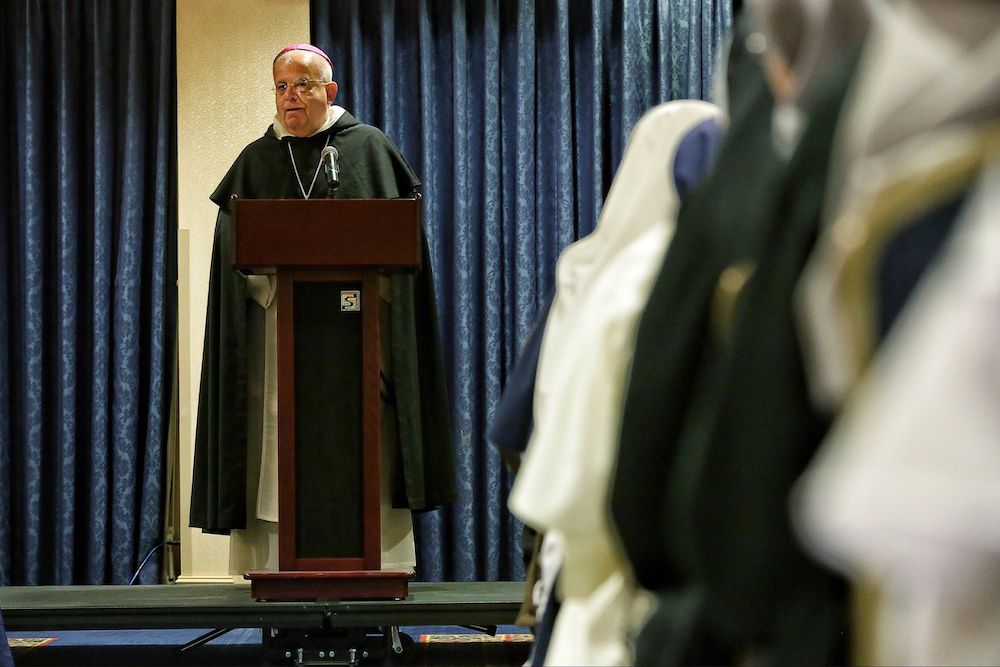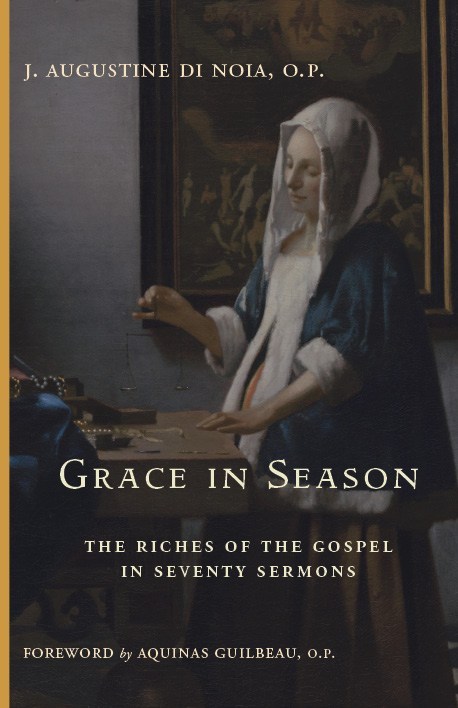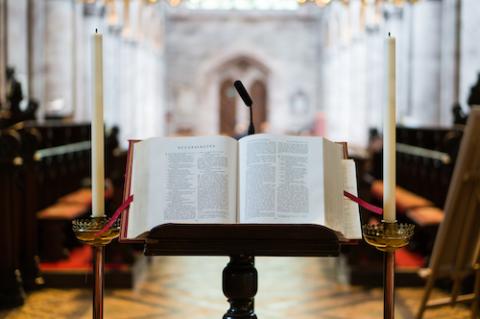
Archbishop J. Augustine Di Noia, adjunct secretary of the Congregation for the Doctrine of the Faith, delivers the keynote address for the Council of Major Superiors of Women Religious symposium in St. Louis Nov. 13, 2015. (CNS/St. Louis Review/Lisa Johnston)
As I was finishing Steven Waldman's book on religious liberty and a re-read of H. Richard Niebuhr's magnificent Christ and Culture, three books for review arrived at about the same time, all of them written by friends. I began thumbing through them to decide which one to undertake first, and something happened to me that almost never happens to me: I received an omen.
In Dominican Archbishop J. Augustine DiNoia's new collection of sermons, Grace in Season, the very first sermon in the book is entitled "His Blessings Flow Far as the Curse Is Found." That sounded very familiar and not only because the words are taken from the refrain in the third verse of the Yuletide hymn "Joy to the World." I checked the index and DiNoia preached that sermon at Midnight Mass at the Dominican House of Studies in 2012. That was the year my border collie, Clementine, needed emergency back surgery on Dec. 21, frustrating my plans to go to Connecticut to be with my dad for the holiday. It was also too late to procure tickets to the Midnight Mass at my parish, St. Matthew's Cathedral, which was always a bit of a mob scene anyway. So, I went to the Dominican House and heard DiNoia preach this very sermon with which he begins his new book. It was splendid then. It is still splendid.
 So are the rest of the Christmas sermons printed here. DiNoia's sermons are, as one might expect from someone who has worked at the Congregation for the Doctrine of the Faith for many years, heavy on doctrinal content. But they are leavened by a command of the English language and a knack for metaphors that makes them incredibly moving.
So are the rest of the Christmas sermons printed here. DiNoia's sermons are, as one might expect from someone who has worked at the Congregation for the Doctrine of the Faith for many years, heavy on doctrinal content. But they are leavened by a command of the English language and a knack for metaphors that makes them incredibly moving.
For example, in that first sermon he quotes St. Leo: "The Conqueror's victory would have profited us nothing if the battle had been fought outside our human condition." DiNoia continues:
Born into our human nature, Christ makes it possible for us to be reborn as his brothers and sisters in the communion of Trinitarian love. By assuming our human frailty, the sinless one is victorious within the very arena of earthly existence where we lay under the curse, condemned to sin and death. Not from outside, but from within this arena, he comes to make his blessings flow. Like a flowing river, the uncontainable surge of his grace streams into every crevice and corner of our lives sweeping away our sins and sorrows, and all the thorns that infect the ground. How far? Far as the curse is found, deep into the dark fissures of our hearts where the thorns of envy and malice, pride and lust, greed, hatred and despair would find a niche and thrive. How far then do his blessings flow? Far as the curse is found.
I think that is just stunningly beautiful.
This is not the only sermon in which DiNoia wraps his theme around a verse of a hymn, something I find very powerful in liturgy. Say that a preacher at a funeral invokes an image or words, for example, the last verse of "At that first Eucharist, before you died":
So, Lord, at length when sacraments shall cease,
May we be one with all thy Church above,
One with thy saints in one unbroken peace,
One with thy saints in one unbounded love;
More blessed still in peace and love to be
One with the Trinity in Unity.
And the priest develops that beautiful, and doctrinal, link between the sacraments here and now and the banquet in heaven of which they are a foretaste. Then, at the conclusion of the homily, the congregation stands and sings that hymn at the Offertory. I predict that some of the people in that congregation will be in tears. At least they were at my mother's funeral when this sequence came to pass.
Two of DiNoia's sermons were explicitly inspired by Pope Francis. His Easter morning sermon "Mary Magdalene, the Apostola Apostolorum" begins with the Eastern Church tradition of exchanging bright red Easter eggs with the greeting "Christ is Risen," to which one responds, "He is risen indeed." This tradition begins with Mary Magdalene who, according to the Gospel of John, was the first to find the empty tomb, the first to encounter the risen Christ, and the one who communicated this amazing news to the apostles. I did not realize that her title of "Apostle to the Apostles" goes back to the second century as DiNoia explains. He then picks up on Francis explaining that Mary Magdalene perceives Christ through her tears, and asking if we have received the gift of tears as well. Unwilling to end an Easter morning sermon on the topic of tears, he entertains with a brief disquisition on the Bavarian practice of making the congregation laugh on Easter Sunday, the risus paschalis.
Advertisement
The other sermon inspired explicitly by the Holy Father is entitled "The Wounds of Jesus Are Wounds of Mercy" and it was preached on Divine Mercy Sunday this year. "Christ never appears to his disciples after his resurrection without his wounds," DiNoia writes:
He appears not as a ghost or a phantom, not in the camouflage of a generic human body, but in the body that has always been his, at once son of God and son of Mary, who was crucified for sake under Pontius Pilate, who suffered died and was buried, and who rose again on the third day in accordance with the Scriptures. His body is transformed and glorified but is really his own for it bears the very wounds of his passion.
I wish more preachers would work prayers, especially the creed, into their sermons as well as drawing on the Scripture reading. But DiNoia does more. Later in the sermon, he offers an invitation: "Picture this if you dare: Christ standing before his heavenly Father and pleading for us, still bearing his wounds." His sermons are filled with invitations to imagine in concrete terms what are the doctrinal implications we hold, a trait he shares with the Holy Father.
There are other sermons I could highlight. His sermon a couple of weeks after the killings in Newtown, Connecticut, is extraordinary. Another Christmas sermon, "He Came to Earth to Lead Us to the Stars" includes these beautiful sentences: "An empty manger becomes the first crib of the Lord of the universe. Fodder gives way to the bread of angels. Approaching the manger now — his table — we find not fodder but the bread come down from heaven." His sermon on "The Mystery of the Eucharist" is magnificent. The sermon preached at his mother's funeral, which I was also privileged to hear at that time, is poignant and profound. I remember thinking after that sad event that if DiNoia is still with us at the time of my demise, I should like him to preach at my funeral.

(Unsplash/Stephen Radford)
DiNoia's collection is a perfect spiritual companion for anyone. You might want to give this volume to your parish priest as a gift, although the implication would be clear that you are expecting better preaching! But we the people of God should expect better preaching. Too often, we get a bit of exegesis and some encouragement to behave better. Too many preachers have become slaves to the reading and do not seek, and so they do not find, creative ways to preach about the sacraments and the creed and other doctrines of the faith. It is expecting too much for most priests to have the erudition found here, and Dominicans are, after all, preachers first and foremost.
But keep this book near your bedside and follow its contents through the year. You will find your faith strengthened and challenged in equal measure by these profound and invitational sermons. And if your parish priest is challenged to work a bit harder on his Sunday sermon, so much the better.
[Michael Sean Winters covers the nexus of religion and politics for NCR.]
Editor's note: Don't miss out on Michael Sean Winters' latest. Sign up and we'll let you know when he publishes new Distinctly Catholic columns.








